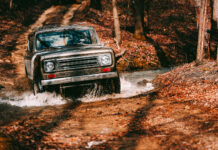
The 2015 Dakar Rally starts on January 3rd and among them will be one very special team. Catherine Houles and Sandrine Ridet are not special because they are the only all-female team. They are special, because they are Gazelles.
The Rallye Aicha des Gazelles is often compared to the Dakar. On the surface, they are quite similar. Both are multi-day navigational off-road rallies. Competitors in both rallies return to a bivouac at night. Both penalize competitors for missing check points.
While they are both navigational rallies, they go about it in very different ways.
In the Dakar, competitors are given a roadbook with total kilometers, a “tulip drawing” or basic drawing of the direction change, the heading, and any dangers one can expect to find. GPS is allowed, but its function is limited. The GPS does not display turn by turn directions. Instead it only shows the heading and speed until competitors pass within 800 meters of a waypoint. At that time, the GPS will display current heading and speed, as well as the heading and distance to the waypoint.

The navigator has to interpret the road book data and do basic math as well. The roadbook will often give CAP headings. If the car is following a CAP of 20 degrees, and the new CAP is 110 degrees, then a 90 degree right hand turn is called for. A new CAP of 290 degrees would mean a 90 degree left hand turn. All of this is done while the car is moving and bouncing over the terrain!

The Gazelle Rally is a little, okay, a lot different. The goal is to get to each checkpoint in the shortest distance, not the fastest time. Competitors are only given map coordinates, which they plot on a topographical map. They then use old school rulers to find their heading and distance. At the starting line, the navigator uses her compass to find the direction, and the team attempts to stay on the heading and drive as straight as possible to the checkpoint.

And yes, I said “her”. The Gazelle Rally is the only all female rally of it’s kind.
Of course, driving in a straight line is easier said than done. Washes, dunes, mountains, palmeries, camel grass…all these things stand in the Gazelles’ way. It is up to the team to decide to go through the obstacle, at the risk of getting stuck or harming their vehicle. The other option is to navigate around it, at the risk of losing their heading and adding kilometers.

Since time is not important in the Gazelle Rally (although competitors do want to manage their time so that checkpoints are attained in the day light), navigation is done with the truck stopped. The navigator will get out of the truck and step away 10 meters or so to get an accurate compass reading, as the electronics of the truck may interfere with the compass. Car compasses are allowed, but they are not as accurate as an outside reading.
There are no chase vehicles, no cell phones, and absolutely no GPS in the Gazelle Rally.

Both Houles and Ridet are experienced Gazelles, but first time Dakar participants. They will be driving an Isuzu D-Max and are traveling to Dakar with two support cars, two mechanics, and one team manager. The D-Max, which shares it’s platform with the Chevy Colorado, is powered by a 3.0L turbo diesel. It knocks out 161 hp and 265 lb/ft of torque. It’s relatively light weight makes it great in the dunes and it’s 4×4 system can carry it over most anything (if taken at the correct speed).
Houles will be the driver, Ridet – the navigator. Ridet has participated in the Gazelle Rally since 2008, seven as a driver, one as a navigator. Will her dead reckoning navigation skills help her find her way in the Dakar?

Their only goal is to finish. You can follow them at www.dakar.com. They will be running number 422.
Technical verifications take place on January 1-3 in Buenos Aires and competitors are off the line on January 3rd at 3pm. Competitors will return to Buenos Aires for the big finish on January 17th.
Emme is a driver, reviewer, rabble rouser, and Gazelle who can be found online on Facebook, Twitter, Instagram, and either one of her blogs.


























